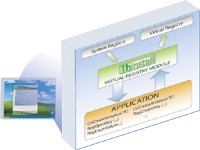
| Introduction |
Previous Top Next |



| · | Process Loading. The VM loads a starting EXE file from the Virtual Filesystem and allows it to execute any other EXE directly from the Virtual Filesystem or from the normal filesystem. |
| · | DLL Loading. The VM loads any DLL dependencies your EXE/DLL/OCX files may have directly from archive when instructed. The VM can import and use DLLs located on the normal filesystem as well as the Virtual File System. The VM provides full control over which DLLs you want to use, making it possible to entirely eliminate "DLL Hell" problems without relying on Windows XP "Side-by-side" features. |
| · | Thread & Process Management. The VM is responsible for keeping track of all threads created inside the virtual machine. The VM manages thread-local storage, notifies Dlls about new process threads, and manages memory for thread stacks. |
| · | The VM runs on all versions of 32bit Windows platforms (95/98/ME/NT/2k/XP) without installation, drivers, reboots, or administrator access. |
| · | VFS is always compressed on disk, meaning your installed disk footprint is the same as the pre-install footprint. |
| · | VFS provides transparent decompression for files accessed inside the VFS. |
| · | VFS provides transparent encryption/decryption for file writes/reads inside the VFS. |
| · | VFS allows all processes and libraries loaded through the VM to access files from both the VFS and the normal filesystem. |
| · | The VFS presents a "merged view" of the filesystem to applications run by the VM. Files from both systems can appear in the same directory. |
| · | The VFS works with any underlying filesystem, including FAT32, NTFS, Network shares, and any future filesystem. |

| · | Virtual registry allows COM/ActiveX based applications to run on systems where registry access has been restricted. |
| · | Supports In-Process (DLL/OCX) and Out-of-process (EXE) servers. |
| · | COM and ActiveX controls can be loaded directly from the VFS, eliminating all possibility of removal by another application's uninstall. |
| · | Virtual Registry exists inside your EXE, so it cannot be misconfigured by another program's installer or uninstaller. |
| · | Registry recording system allows you to record all registry keys a COM/ActiveX control would normally create during "Regsvr32". Recording occurs on the development computer, and is simulated in the runtime environment. |
| · | The VREG system automatically tracks COM object lifetimes so that it can free DLL and EXE servers. |
| · | Install/Uninstall remains integrated with your EXE |
| · | Allow the user to chose the installation directory |
| · | Add Startmenu shortcuts to launch or uninstall your program or link to websites |
| · | Add a desktop shortcut to your program |
| · | Add a control panel uninstall option in Add/Remove Programs |
| · | Display a custom BMP file in the installation dialog |
| · | Warn users when they try to run a different version from the one installed. |
| · | Display a license agreement window before running the application |
| · | Install options can be made automatic so no user interaction is required to install. |
| · Packaged applications are protected from disassembly, reverse engineering, and disk patching to a high degree |
| · Packaged datafiles are protected from user inspection, and writes to datafiles can be cached with transparent encryption. |